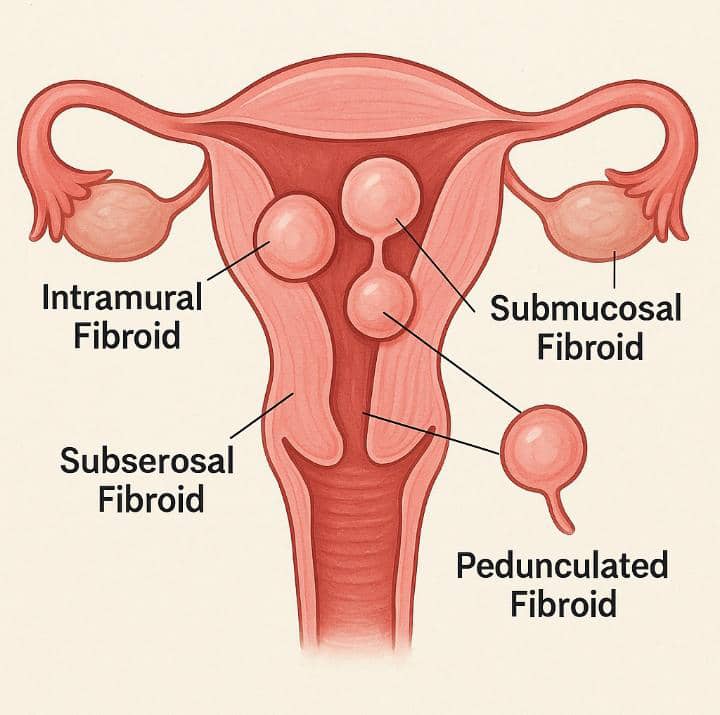THE TRUTH ABOUT FIBROIDS: CAUSES, CURES, AND CARE OPTIONS
By Marilyn Ossai
Fibroids (those non-cancerous growths in or around the womb) don’t have one clear cause, but doctors believe they develop because of a mix of hormones, genetics, and lifestyle factors. Here’s what’s behind them:
- Hormones (Estrogen & Progesterone): These two hormones (the ones that control your menstrual cycle) make the lining of the womb grow every month, and they also seem to encourage fibroid growth. That’s why fibroids often grow during childbearing years and shrink after menopause.
- Genetics: If your mum, sister, or grandmother had fibroids, you’re more likely to have them too.
- Lifestyle & Diet Factors: Being overweight or obese increases the risk. Eating lots of red meat (like beef) and not enough fruits and vegetables may play a role too.
- Other Factors:
- Starting your period very early.
- High blood pressure.
- Vitamin D deficiency.
Most fibroids don’t cause symptoms, but when they do, it can be heavy periods, pelvic pain, or frequent urination.
What is Considered an Early Period?
An early period (in this case) means when a girl starts menstruating (her first period) earlier than normal.
- Normal age for first period (menarche): Usually between 11 and 14 years old.
- Early period (early menarche): If a girl starts her period before age 11 (especially before age 9 or 10), it’s considered early. This early exposure to estrogen is one of the things linked to a slightly higher chance of fibroids later in life.
How To Prevent Fibroids And Shrink Them Naturally:
- Balance your hormones (estrogen, especially):
- Eat more fruits & veggies.
- Foods high in antioxidants, like berries, spinach, and carrots, help control hormone levels.
- Cut down on red meat (like beef & pork) and processed foods.
- Include healthy fats (avocado, olive oil, nuts) – they support hormone balance.
- Drink green tea (it contains EGCG, which studies show can shrink fibroids).
- Maintain a healthy weight:
- Excess body fat makes the body produce more estrogen, which fuels fibroid growth.
- Losing even a small amount of weight helps.
- Get enough Vitamin D:
- Low vitamin D is linked to fibroids. Spend time in sunlight or take a supplement (but ask a doctor for dosage).
- Herbal remedies (but use carefully):
- Turmeric & Ginger: Reduce inflammation.
- Castor oil packs on your belly may help reduce pain and improve circulation.
- Milk thistle or DIM supplements: Help your liver break down excess estrogen.
- Stay active:
- Regular exercise (30 mins daily) helps balance hormones and improve blood flow to the womb.
- Avoid triggers: Stay away from plastics with BPA (like bottled water left in sun).
- Reduce alcohol & caffeine.
Common Symptoms of Fibroids (but remember, some women don’t feel anything at all):
- Heavy or prolonged periods (menorrhagia):
- Bleeding so heavy that you soak through pads or tampons in 1–2 hours.
- Period lasting more than 7 days.
- Passing big blood clots during your period.
- Pelvic pain or pressure:
- Feeling a dull, constant ache or pressure in your lower belly.
- Some women describe it as a “fullness” like they’re bloated all the time.
- Frequent urination:
- You feel like you need to pee all the time because the fibroid is pressing on your bladder.
- Constipation or difficulty passing stool:
- If the fibroid presses on your bowels.
- Pain during sex (dyspareunia):
- Especially if the fibroid is close to the vaginal canal.
- Fertility or pregnancy issues:
- Trouble getting pregnant or repeated miscarriages (but not all fibroids cause this).
- Abdominal swelling:
- Your belly may look bigger, like you’re pregnant (if the fibroid is large).
Types of Fibroids and Their Symptoms
Fibroids are grouped based on where they grow in or around the womb:
Types of Fibroids and Their Symptoms
Fibroids are grouped based on where they grow in or around the womb:
- Intramural Fibroids (inside the wall of the womb): Most common type.
Symptoms: Heavy bleeding, pelvic pain, bloating, and sometimes infertility.
- Submucosal Fibroids (inside the womb cavity): Less common but cause the most bleeding problems.
Symptoms: Very heavy/prolonged periods, severe cramps, infertility or miscarriages.
- Subserosal Fibroids (outside surface of the womb): Grow outward, pressing on other organs.
Symptoms: Back pain, bloating, frequent urination, or constipation.
- Pedunculated Fibroids (on a stalk): Can grow inside or outside the womb, hanging like a mushroom.
Symptoms: Sudden sharp pain if the stalk twists.
Signs Your Fibroid is Serious & Needs Urgent Attention
Run to a hospital or doctor if you notice:
- Excessive bleeding:
- Soaking a pad/tampon every 1–2 hours for several hours.
- Dizziness, weakness, or fainting from blood loss.
- Severe pelvic pain:
- Pain so bad it stops you from moving or doing normal things.
- Rapid belly growth:
- Abdomen swelling fast like pregnancy.
- Trouble peeing or passing stool:
- If you can’t urinate properly or have severe constipation.
- Repeated miscarriages or infertility:
- Fibroids in certain locations can block sperm or a baby from implanting.
Where Each Type of Fibroid Grows (With Simple Diagram Description)

- Intramural Fibroid
Where? Inside the muscle wall of the womb.
Effect? Makes the womb look bigger and causes heavy bleeding & pain.
Think of it like a lump inside bread dough.
- Submucosal Fibroid
Where? Just under the lining of the womb (endometrium).
Effect? Worst for heavy periods, infertility, and miscarriages because it distorts the womb cavity.
- Subserosal Fibroid
Where? On the outer surface of the womb.
Effect? Presses on the bladder/bowel, causes bloating & frequent urination.
- Pedunculated Fibroid
Where? Hanging by a stalk inside or outside the womb.
Effect? Can cause sharp pain if the stalk twists (called “torsion”).
Treatments for Fibroids
- Natural Remedies (for small or medium fibroids):
Green Tea (EGCG): Helps shrink fibroids slowly.
Turmeric & Ginger: Reduce inflammation and pain.
Castor Oil Packs: Placed on your lower belly to improve blood flow and shrink fibroids.
Eat hormone-balancing foods (broccoli, cabbage, flaxseed).
- Medical Treatments (for large or stubborn fibroids):
Medications (like hormone blockers) to shrink fibroids.
- Surgical Options:
Myomectomy: Removes only the fibroid (good if you still want babies).
Hysterectomy: Removes the womb (last resort if you’re done with childbirth).
Uterine Fibroid Embolization (UFE): Blocks blood supply to fibroids so they shrink.
Best Natural Remedies to Shrink Fibroids
- Green Tea (EGCG)
Drink 2–3 cups daily. The antioxidants reduce fibroid size and inflammation.
- Castor Oil Packs
Place a warm castor oil cloth on your lower belly for 30–60 minutes, 3–4 times a week. Improves circulation and helps your body break down excess tissue.
- Vitex (Chasteberry)
A herbal supplement that balances estrogen & progesterone. Take 400–1,000mg daily.
- Turmeric & Ginger Tea
Drink daily for anti-inflammatory effects.
- DIM supplements (Diindolylmethane)
Found in cruciferous vegetables, or take as a capsule. It helps your liver clear out excess estrogen.
- Avoid Endocrine Disruptors
Stay away from plastics (use glass instead). Avoid cosmetics with parabens.
- Get Vitamin D
Spend 15–30 minutes in the sun daily or take a Vitamin D3 supplement (ask a doctor for dosage).
- Red Raspberry Leaf Tea
Strengthens the uterine wall and balances hormones.
Sample Fibroid-Shrinking Daily Food Plan
- Morning (Breakfast):
Warm lemon water (flushes toxins)
Smoothie: Handful spinach, 1 banana, 1 tbsp flaxseed (balances hormones), Almond milk, A scoop of plant-based protein powder
- Mid-Morning Snack:
Green tea + a handful of walnuts or pumpkin seeds
- Afternoon (Lunch):
Steamed broccoli, kale, cabbage, and carrots (cruciferous veggies clear estrogen)
Grilled salmon or mackerel (anti-inflammatory omega-3)
Brown rice or quinoa
- Evening Snack:
Sliced apples or berries with a tablespoon of almond butter
- Night (Dinner):
Turmeric ginger tea
Baked sweet potato
Lentil or chickpea stew with garlic & onions (anti-fibroid foods)
- Before Bed:
Warm chamomile tea + 1 Brazil nut (supports thyroid & hormone health.




